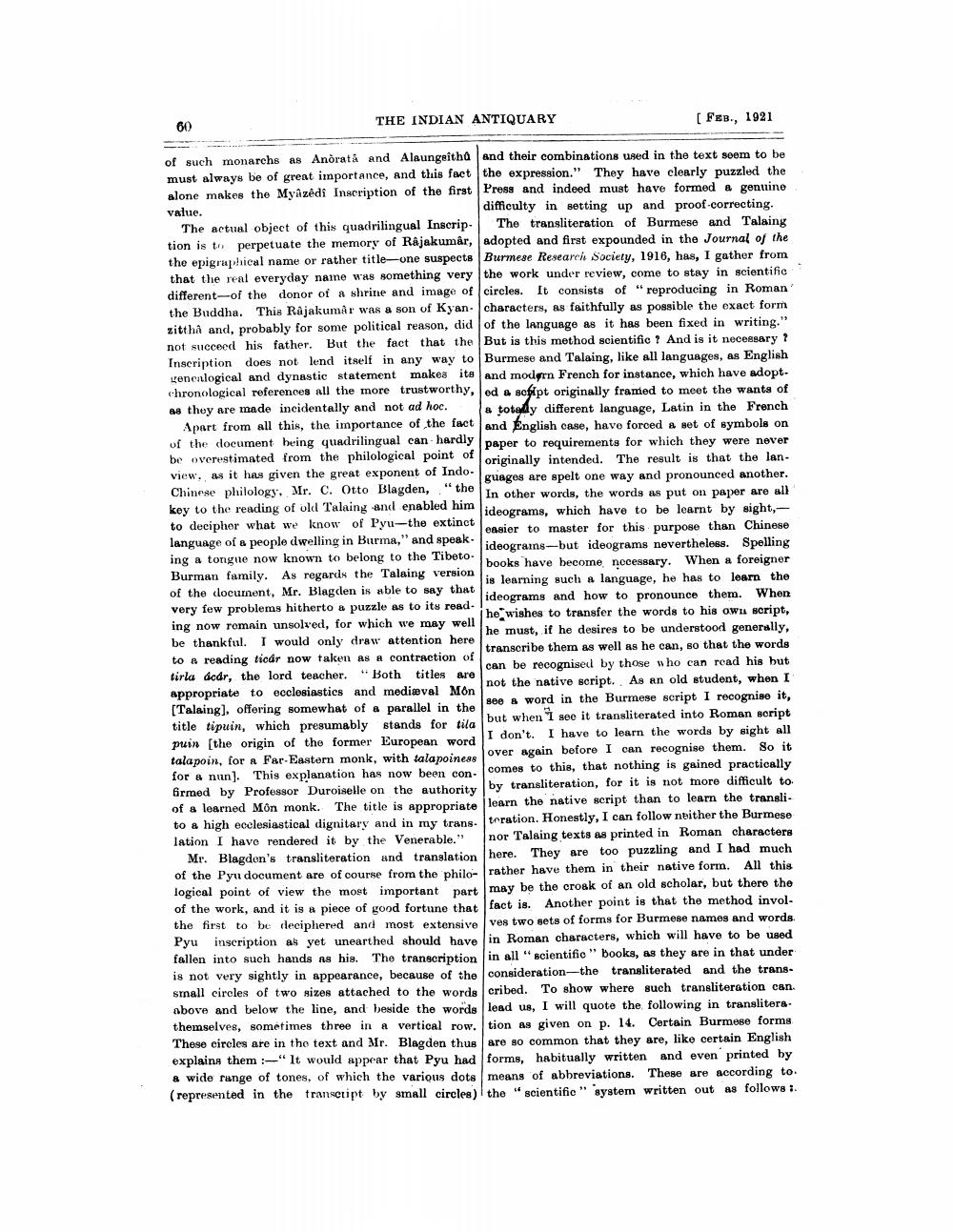________________
60
THE INDIAN ANTIQUARY
[ FEB., 1921
of such monarchs as Anorata and Alsungeitha and their combinations used in the text seem to be must always be of great importance, and this fact the expression." They have clearly puzzled the alone makes the Myâzédi Inscription of the first Press and indeed must have formed a genuine value.
difficulty in setting up and proof-correcting. The actual object of this quadrilingual Inscrip. The transliteration of Burmese and Talaing tion is to perpetuate the memory of Rajakumar, adopted and first expounded in the Journal of the the epigraphical name or rather title-one suspects Burmese Research Society, 1916, has, I gather from that the real everyday name was something very the work under review, come to stay in scientific different-of the donor of a shrine and image of circles. It consists of "reproducing in Roman the Buddha. This RajakumÅr was a son of Kyan characters, as faithfully as possible the exact form zitthå and, probably for some political reason, did of the language as it has been fixed in writing." not succeed his father. But the fact that the But is this method scientific ? And is it necessary ? Inscription does not lend itself in any way to Burmese and Talaing, like all languages, as English venealogical and dynastie statement makes it and modern French for instance, which have adoptchronological references all the more trustworthy, lod a sofipt originally framed to meet the wants of As they are made incidentally and not ad hoc. la totally different language, Latin in the French
Apart from all this, the importance of the fact and English case, have forced a set of symbols on of the document being quadrilingual can hardly paper to requirements for which they were never be overestimated from the philological point of
originally intended. The result is that the lanview, as it has given the great exponent of Indo.
guages are spelt one way and pronounced another. Chinese philology, Mr. C. Otto Blagden," the
In other words, the words as put on paper are all key to the reading of old Talaing and enabled him
ideograms, which have to be learnt by sight,to decipher what we know of Pyu-the extinct
easier to master for this purpose than Chinese language of a people dwelling in Burma," and speak.
ideograms--but ideograms nevertheless. Spelling ing a tongue now known to belong to the Tibeto.
books have become necessary. When a foreigner Burman family. As regards the Talaing version
is learning such a language, he has to learn the of the clocument, Mr. Blagden is able to say that
ideograms and how to pronounce them. When very few problems hitherto a puzzle as to its read-1.
he wishes to transfer the words to his own script, ing now remain unsolved, for which we may well
he must, if he desires to be understood generally, be thankful. I would only draw attention here
transcribe them as well as he can, so that the words to a reading ticar now taken as a contraction of tirla dedr, the lord teacher." Both titles are
can be recognised by those who can read his but appropriate to ecclesiastics and medieval Môn
not the native script. As an old student, when I [Talsing), offering somewhat of a parallel in the
See & word in the Burmese script I recognise it, title tipuin, which presumably stands for tila
but when I see it transliterated into Roman script puin (the origin of the former European word
I don't. I have to learn the words by sight all talapoin, for a Far Eastern monk, with talapoiness
over again before I can recognise them. So it for a nun). This explanation has now been con
comes to this, that nothing is gained practically tirmed by Professor Duroiselle on the authority I by transliteration, for it is not more difficult to of a learned Môn monk. The title is appropriate learn the native script than to learn the translito a high ecclesiastical dignitary and in my trans.trration. Honestly, I can follow neither the Burmese lation I have rendered it by the Venerable," nor Talaing texts as printed in Roman characters Mr. Blagden's transliteration and translation here. They are too puzzling and I had much
rather have them in their native form, All this logical point of view the most important part
may be the croek of an old scholar, but there the of the work, and it is a piece of good fortune that I fact is. Another point is that the method involthe first to be deciphered and most extensive ves two sets of forms for Burmese names and words Pyu inscription as yet unearthed should have in Roman characters, which will have to be used fallen into such hands as his. The transcription in all scientifio books, as they are in that under is not very sightly in appearance, because of the consideration-the transliterated and the transsmall circles of two sizes attached to the words cribed. To show where such transliteration can above and below the line, and beside the words lead us, I will quote the following in translitera. themselves, sometimes three in a vertical row. tion as given on p. 14. Certain Burmese forms These circles are in the text and Mr. Blagden thus are so common that they are, like certain English explains them :-" It would appear that Pyu had forms, habitually written and even printed by & wide range of tones, of which the various dots means of abbreviations. These are according to (represented in the transcuipt by small circles) the scientific" system written out as follows:




